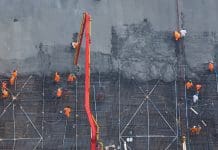The public profile of the demolition industry has been raised by the recent airing of the Channel 5 documentary “When Demolitions Go Wrong” which has focused on the impact of incidents but not the underlying causes
HSE looks at the learning points from incidents that have occurred during demolition and significant refurbishment and has collected a number of case studies that cover a range of health, safety and commercial incidents, some of which resulted in death or serious injury and others which could easily have led to single or multiple casualties. In all cases, even where there were no casualties, additional commercial costs often exceeded any potential saving resulting from shortcuts.
Failure to provide sufficient pre-demolition information by client
A contract to demolish high rise residential blocks built of large precast panels used a ground based high reach demolition machine. The client provided little information on the building structure to the contractor. Structural connection between panels had been poorly designed, poorly built and had deteriorated further during the life of the building. Lack of adequate information (and lack of adequate survey or assessment prior to work starting) led to a premature collapse of multiple floors across several bays during demolition works.
Fortunately, because the high reach machine was large enough, as was the exclusion zone, there were no injuries. However, the project was substantially delayed while the incident was investigated, and remedial action taken. This type of building often needs panel connections to be stiffened and floors propped to a formal design prior to demolition.
Contractor competence. Basement extension work poorly designed and executed
A community building used daily by a local playgroup had a new basement dug out by tunnelling underneath the building across the full perimeter. Support was provided by a couple of Acrows and the sides of the excavation were not shored up while underpinning was carried out in stages. The contractor believed he was working in solid rock but in reality, it was loose shale. Emergency works to prop the cavern and save the building made further work extremely difficult. This caused the contractor to go out of business.
All excavations and especially where they are beneath or close to existing structures need to be meticulously designed and carried out which allows the cost of temporary works to be factored in and understood from an early stage.
Contractor competence. Approved sequence not followed causing collapse
The method statement for construction of a rear extension called for a new strip concrete foundation along the full length of the existing property to be installed in 1 metre sections, to avoid undermining existing foundations. The builder decided it would be quicker to dig the full length of the trench in one go.
The existing building collapsed into the excavation injuring several workers. The method statement should have been followed but other types of foundation could have been considered – including short bored piles or pads and a ground level ring beam.
Failure to correctly assess existing structure
Demolition workers assessed the form of construction of a single storey, concrete slab roofed building on the hoof and decided that because the soffit was flat and unjointed that the roof must have been cast in-situ and would be reinforced in both directions. They punched a hole in one wall for plant access and were working inside when several of the precast, reinforced concrete roof planks hinged down killing one of them.
The punched hole had removed its bearing. The soffit was smooth because it had been plastered with grey gypsum and the roof felting masked the upper surface. Simple further checks and clues would have revealed the form of construction.
Cast in-situ slabs are not necessarily fully reinforced in both directions and in some cases suspended slabs are not reinforced at all. Simple equipment is available to check for the presence and direction of steel reinforcement. Safe intrusive methods of checking are also available – such as core drilling or limited breakout – e.g. from a tower scaffold. Where possible, machine demolition from the ground and an exclusion zone is preferred and where this isn’t possible designed back-propping could have reduced the risk of wholesale failure.
Temporary load on existing structure not assessed
Demolition temporary works design considered mobile plant loadings on suspended reinforced concrete floor slabs but did not consider the rubble ramps that the contractor intended to use to allow plant to track down onto each floor in turn. The contractor didn’t realise the rubble ramp hadn’t been assessed.
The floor became overloaded and collapsed progressively taking out floors below resulting in fatal and major injuries. Had the task been fully assessed the need for back-propping or floor to floor transfer by crane would have been obvious.
Failure to consider implications of removing cross walls
A large brick building was being converted into flats. Neither the designer nor the contractor considered the effect of proposed alterations to the existing structure. All internal walls and floors were removed in one go leaving the brick shell and roof in place. The internal cross walls and floor joists had been providing support to the external walls which were now too long to resist wind loading without movement.
The building collapsed while the site was closed and before new walls and floors could be installed. The permanent works designer should have considered the effect of necessary demolition work. In some cases, designing a phased sequence of installing new walls and floors before removing old ones can be used to ensure stability is maintained throughout the process. An alternative approach is formal design and early installation of extensive temporary works to provide support.
Support provided by non-loadbearing elements
All structural works on a masonry building were stopped due to concern about its stability. The contractor took out some window frames they thought were non-structural. These were providing sufficient fortuitous support to hold up a gable wall which collapsed causing other parts of the building to collapse. Several were killed and injured. Older buildings may need a designed internal and/or external structural scaffold or steel frame to hold them up while structural refurbishment is carried out.
Load bearing elements removed during soft strip
Timber sheathing panels were removed during soft stripping of a single storey timber frame school building that was being demolished. The building, including the roof collapsed onto workers who were still inside. No one had checked or realised that the plywood panels were structural and were bracing the timber frame. Once they were removed the building was no longer stable. Fortunately, only minor injuries resulted. A proper survey of the structure would have identified the form of construction and the lack of separate bracing.
Agreed sequence not followed causing scaffold collapse
A large sheeted scaffold screen incorporating access platforms was designed and erected to encase a building. The sheeting prevented dust and debris falling into surrounding public areas while the building was demolished floor by floor by small excavators. The scaffold was supposed to be dismantled progressively as each floor was demolished. It was not. The wind got up and the sail effect overloaded ties into the remains of the building. These failed and the scaffold collapsed onto a town centre public road.
Fortunately, the Fire Service had been called to reports of the scaffold moving and had been able to evacuate the area so there were no casualties. Demolition work should have been halted at the right stage until the scaffold contractor had attended to reduce the height of the scaffold.
Existing structure overloaded by removed materials
A refurbishment contractor created openings in internal walls to a prepared design but stored the bricks on a suspended timber floor for reuse. The floor became overloaded and collapsed injuring several workers. In some instances, materials can be stored close to point of use in order to minimise manual handling. In other situations, this can overload the structure. A temporary works engineer would have been able to advise on how much load the floor could take and how to place load to minimise risk.
Designer instructions not clear & contractor too keen
A building contractor was engaged to construct an extension to an occupied old people’s home. The architect specified that foundations should be dug down to competent ground and then agreed with local Building Control. The contractor tried to excavate foundation trenches but could not find competent ground, so he excavated an unsupported foundation pit with the intention of using formwork to create the strip foundation.
When he reached 4 metres depth he found competent ground. His efforts to prop and stabilise a cast iron 250mm diameter live water main that he found at the edge of his excavation were somewhat haphazard but fortunately the main did not fail – if it had the existing building shallow foundations would have been washed out, adding to risk of rapid collapse of the occupied building. The local water supplier discovered what was going on and the excavation was concrete filled as emergency works.
The architect should have been mindful that the building was occupied and given a clearer specification. A soil survey could have been commissioned to check conditions which would have suggested a range of alternative foundation options – including bored mini piles or a raft. Risk to residents, delays and high additional cost could have been avoided.
Unchecked change to system of work caused collapse
A cinema was being demolished and the workers decided to speed up the job by toppling long span roof trusses to the ground instead of lifting them down as per the method statement. This caused a section of concrete roof slab to move and topple the upper masonry storey which in turn pushed the perimeter scaffold away from the building, so it overturned and fell across a high street.
Vehicles and members of the public were trapped beneath it. It stopped just short of a supermarket plate glass window completely blocking the road. By sheer luck no fatalities or major injuries resulted. The planned and designed sequence of work must always be followed unless changes are fully assessed and agreed by the design team.













